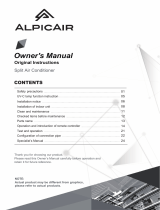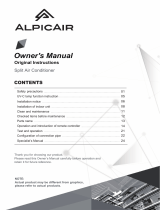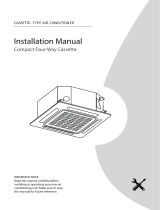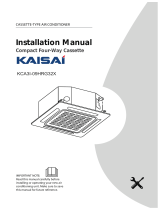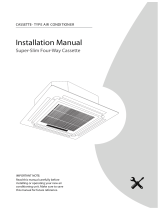Page is loading ...

Installation
Manual
DUCTED AIR CONDITIONER
KDI Series
KDI24

2 | Kaden Installation Manual
Important note
This appliance must be installed in accordance with:
Manufacturer’s Installation Instructions
Current AS/NZS 3000, AS/NZS 5149
Local Regulations and Municipal Building Codes including
local OH&S requirements
This appliance must be installed, maintained, and removed
only by an Authorised Person.
For continued safety of this appliance, it must be installed
and maintained in accordance with the manufacturer’s
Instructions.
REFRIGERANT
R32

Kaden Installation Manual | 3
Table of contents
Important note
Read this manual carefully before installing
or operating your new air conditioning unit.
Make sure to save this manual for future reference.
1. Safety precautions 4
Note about fluorinated gases 5
2. Accessories 6
3. Installation summary 7
4. Indoor unit installation 8
Indoor unit parts 8
Safety precautions 8
Indoor unit installation instructions 9
Installation place 9
Maintenance space 10
5. Outdoor unit installation 15
Outdoor unit installation instructions 15
Outdoor unit specifications 16
Drain joint installation 17
Notes on drilling hole in wall 17
6. Drainpipe installation 18
Note on drainpipe installation 18
7. Refrigerant piping connection 20
Safety precautions 20
Note on pipe length and elevation 20
Refrigerant piping connection instructions 21
Note on minimum bend radius 23
8. Leak testing and evacuation 24
Leak, pressure test and evacuation 24
Preparations and precautions 25
Before performing evacuation 25
Opening outdoor unit valves 25
Note on adding refrigerant 25
9. Wiring 26
Safety precautions 26
Signal wiring between outdoor and indoor units 28
Indoor unit wiring 28
10. Electrical checks 32
Electrical safety checks 32
Before test run 32
During test run 32
11. Test run 33
Before test run 33
Test run instructions 33
12. Manual operations 34
Manual operations 34
Error codes 35

4 | Kaden Installation Manual
1. Safety precautions
Read safety precautions before operation and installation
Incorrect installation due to ignoring instructions can cause serious damage or injury.
The seriousness of potential damage or injuries is classified as either a WARNING or CAUTION.
WARNING
Do not share the electrical outlet with other appliances.
Improper or insufficient power supply can cause fire or
electrical shock.
When connecting refrigerant piping, do not let
substances or gases other than the specified refrigerant
enter the unit. The presence of other gases or
substances will lower the unit’s capacity, and can cause
abnormally high pressure in the refrigeration cycle. This
can cause explosion and injury.
Do not allow children to play with the air conditioner.
Children must be supervised around the unit at all times.
1. Installation must be performed by an authorised dealer or
specialist. Defective installation can cause water leakage,
electrical shock, or fire.
2. Installation must be performed according to the
installation instructions. Improper installation can cause
water leakage, electrical shock, or fire.
3. Contact an authorised service technician for repair or
maintenance of this unit.
4. Only use the included accessories, parts, and specified
parts for installation. Using non-standard parts can cause
water leakage, electrical shock, fire, and can cause the
unit to fail.
5. Install the unit in a firm location that can support the unit’s
weight. If the chosen location cannot support the unit’s
weight, or the installation is not done properly, the unit
may drop and cause serious injury and damage.
6. Only fully qualified licensed personnel should install,
service or carry out maintenance to this air conditioning
unit. All electrical work is to follow local and national
wiring standards and the Installation Manual.
7. You must use an independent circuit and single outlet to
supply power. Do not connect other appliances to the
same outlet. Insufficient electrical capacity or defects in
electrical work can cause electrical shock or fire.
8. For all electrical work, use the specified cables. Connect
cables tightly, and clamp them securely to prevent
external forces from damaging the terminal. Improper
electrical connections can overheat and cause fire, and
may also cause shock.
9. All wiring must be properly arranged to ensure that
the control board cover can close properly. If the
control board cover is not closed properly, it can lead
to corrosion and cause the connection points on the
terminal to heat up, catch fire, or cause electrical shock.
10. In certain functional environments, such as kitchens,
server rooms, etc., the use of specially designed air-
conditioning units is highly recommended.
11. This appliance can be used by children aged from
8 years and above and persons with reduced physical,
sensory or mental capabilities or lack of experience
and knowledge if they have been given supervision or
instruction concerning use of the appliance in a safe way
and understand the hazards involved. Children must not
play with the appliance. Cleaning and user maintenance
must not be made by children without supervision.
This symbol is a CAUTION, and indicates that ignoring instructions may cause moderate injury to your person,
or damage to your unit or other property.
This symbol indicates that you must never perform the action indicated.
This symbol is a WARNING, and indicates that ignoring instructions may cause death or serious injury.

Kaden Installation Manual | 5
CAUTION
Do not install the unit in a location that may be exposed to combustible gas leaks. If combustible gas accumulates around
the unit, it may cause fire.
Do not operate your air conditioner in a wet room such as a bathroom or laundry room. Too much exposure to water can
cause electrical components to short circuit.
1. The product must be properly grounded at the time of installation, or electrical shock may occur.
2. Install drainage piping according to the instructions in this manual. Improper drainage may cause water damage to your
home and property.
Note about uorinated gases
1. This air-conditioning unit contains fluorinated gases. For specific information on the type of gas and the amount, please
refer to the relevant label on the unit itself.
2. Installation, decommissioning, service, maintenance and repair of this unit must be performed by a licensed technician.
3. Product decommissioning and recycling must be performed by a licensed technician.
4. If the system has a leak-detection system installed, it must be checked for leaks at least every 12 months.
5. When the unit is checked for leaks, proper record-keeping of all checks is strongly recommended.
6. Only ARC (Australian Refrigeration Council) licence holders can install and commission this air conditioner. This air
conditioner must be installed to meet the requirements of the current version of AS/NZS 5149.
7. It is illegal to vent some types of refrigerant to the atmosphere.
REFRIGERANT
This appliance uses R32 (difluoromethane) refrigerant, which is a flammable gas class 2.2 according to AS/NZS 5149 and must
be handled by a refrigeration mechanic with appropriate Australian refrigerant handling licence.
• WARNING risk of fire/flammable material. If the refrigerant is leaked, together with an external ignition source, there is
possibility of ignition.
• Read all the OPERATING INSTRUCTIONS carefully before operation.
• Service personnel are required to carefully read the OPERATING INSTRUCTIONS and INSTALLATION MANUAL
before operation.
• Further information is available in the OPERATING INSTRUCTIONS, INSTALLATION MANUAL and the like.
Certain levels of refrigerant require minimum room sizes. Please ensure that these minimum room sizes are adhered to for
standard installations (up to 10m pipe length). If larger refrigerant charges than standard are used then please consult AS/NZS
60335.2.40 to determine the safe minimum floor area for the installation.
Make sure that the area has been made safe by having suitable ventilation and is free from ignition sources before charging or
recovering the charge of R32.

6 | Kaden Installation Manual
2. Accessories
The air conditioning system comes with the following accessories. Use all of the installation parts and accessories to install the air
conditioner. Improper installation may result in water leakage, electrical shock and fire, or cause the equipment to fail.
Name Shape Quantity
Tubing and fittings Soundproof/insulation sheath 2
Cooling and heating
Drain joint 1
Seal ring 1
Others
Owner’s manual 1
Installation manual 1
Display panel
(for testing purposes only) 1
Wired controller 1
EMC magnetic ring Magnetic ring – wrap the electric wires
S1 & S2 around the magnetic ring twice 1

Kaden Installation Manual | 7
3. Installation summary
S1 S2
Install the indoor unit (page 8) Install the outdoor unit (page 15) Install the drainpipe (page 18)
Connect the wires (page 26) Leak test and evacuation
(page 24)
Connect the refrigerant pipes
(page 20)
Connect the signal wires (page 28)
1
6
7
2
5
3
4
Perform a test run (page 33)
8

8 | Kaden Installation Manual
4. Indoor unit installation
Indoor unit parts
Fig. 4.1
Safety precautions
WARNING
Securely install the indoor unit on a structure that can
sustain its weight. If the structure is too weak, the
unit may fall, causing personal injury, unit and property
damage, or even death.
CAUTION
Install the indoor and outdoor units, cables and wires
at least 1m from televisions or radios to prevent static
or image distortion. Depending on the appliances,
a 1m distance may not be sufficient.
Air inlet
Return air
Air outlet
Supply air
Electric control cabinet
Drain hose
Refrigerant
connecting pipe
Air filter

Kaden Installation Manual | 9
Indoor unit installation instructions
Step 1: Select installation location
The indoor unit should be installed in a location that meets the
following requirements:
✓Enough room for installation and maintenance.
✓Enough room for the connecting pipe and drainpipe.
✓The ceiling is horizontal and its structure can sustain the
weight of the indoor unit.
✓The air inlet and outlet are not impeded.
✓The airflow can fill the entire room.
✓There is no direct radiation from heaters.
✓It is embedded installation.
CAUTION
Do not install unit in the following locations:
Where oil drilling or fracking is taking place.
Coastal areas with high salt content in the air.
Near geothermal activity and corrosive gas.
Buildings that may experience power fluctuations.
Enclosed spaces.
Areas with strong electromagnetic waves.
Areas that store flammable materials or gas.
Rooms with high humidity, such as bathrooms
or laundry rooms.
Installation place
Fig. 4.2
Strong and durable ceiling
Indoor unit
Left
side
Right
side
> 100mm > 300mm Service access
> 20mm
> 20mm
> 300mm
Ceiling
Floor
(When no ceiling)
> 2500mm
B

10 | Kaden Installation Manual
Maintenance space
Air inlet 600mm x 600mm
maintenance clearance
Air outlet
≥ 200mm ≥ 300mm
Fig. 4.3
Step 2: Hang indoor unit
1. Please refer to the following diagrams to locate the four positioning screw bolt holes on the ceiling. Be sure to mark the places
where you will drill ceiling hook holes.
B
Air outlet dimensions Air inlet dimensions
Descending ventilation opening and mounted hook
A
F
C
D
E
J
G
I
Air
filter
Air
filter
Electric
control
box
H
Fig. 4.4
Supply air
Return air

Kaden Installation Manual | 11
Table 4.1 (Unit: mm)
Model Outline dimension Air outlet
opening size
Air return
opening size
Size of
mounted lug
A B C D E F G H I J
KDI24 1100 249 774 700 175 926 228 1001 1140 598
Wood
Place the wood mounting across the roof beams, then install
the hanging screw bolts. (See Fig. 4.5)
Fig. 4.5
New concrete bricks
Inlay or embed the screw bolts. (See Fig. 4.6)
Fig. 4.6
Original concrete bricks
Use an embedding screw bolt, crock and stick harness.
(See Fig. 4.7)
Fig. 4.7
Steel roof beam structure
Install and use the supporting steel angle. (See Fig. 4.8)
Fig. 4.8
CAUTION
The unit body must be completely aligned with the hole.
Ensure that the unit and the hole are the same size before
moving on.
2. Install and fit pipes and wires after you have finished
installing the main body. When choosing where to start,
determine the direction of the pipes to be drawn out.
Especially in cases where there is a ceiling involved, align
the refrigerant pipes, drain pipes, and indoor and outdoor
lines with their connection points before mounting the unit.
3. Install hanging screw bolts.
• Cut off the roof beam.
• Strengthen the point at which the cut was made.
Consolidate the roof beam.
4. Drill 4 holes 10cm deep at the ceiling hook positions in the
internal ceiling. Be sure to hold the drill at a 90° angle
to the ceiling.
5. Install the four suspension bolts.
6. Mount the indoor unit with at least two people to lift and
secure it. Insert suspension bolts into the unit’s hanging
holes. Fasten them using the washers and nuts provided.
(See Fig. 4.9)
Roof beam
Ceiling
Hanging screw bolts
Wood mounting
Blade shape insertion Slide insertion
Steel bar
Embedding screw bolt
(Pipe hanging and
embedding screw bolt)
Hanging screw bolt
Hanging bolts Supporting angle steel

12 | Kaden Installation Manual
Fig. 4.9
7. Mount the indoor unit onto the hanging screw bolts with a
block. Position the indoor unit flat using a level indicator to
prevent leaks. (See Fig. 4.10)
Fig. 4.10
NOTE: Confirm the minimum drain tilt is 1/100 or more.
Step 3: Duct and accessories installation
1. Install the filter (optional) according to the size of the
air inlet.
2. Install the flexible tie-in between the body and the duct.
3. The air inlet and air outlet duct should be far enough
apart to avoid air passage short-circuit.
4. Connect the duct according to the following diagram:
Air outlet Air inletAir dust
filter
Checking
orifice
Flexible tie-in
Isolation booth
Fig. 4.11
5. Refer to the following static pressure guidelines when
installing the indoor unit.
Table 4.2
Model Static pressure
(Pa)
KDI24 0~160
Change the fan motor static pressure according to external
duct static pressure.
Note
1. Do not place the connecting duct weight on the
indoor unit.
2. When connecting the duct, use a non-flammable
canvas tie-in to prevent vibrating.
3. Insulation foam must be wrapped outside the duct to
avoid condensate. An internal duct under-layer can be
added to reduce noise, if the end-user requires.
Screw nut
Screw nut
Shockproof cushion
Overhang part
Washer
Hanging
screw bolt

Kaden Installation Manual | 13
Step 4: Adjust the air inlet direction
(from rear side to under-side)
1. Take off the ventilation panel and flange.
Fig. 4.12
2. Change the mounting positions of the ventilation panel and
air return flange.
Fig. 4.13
3. When installing the filter mesh, fit it into the flange as
illustrated in the following figure.
Fig. 4.14
Note
All the figures in this manual are for demonstration
purposes only. The air conditioner you have purchased
may be slightly different in design, though similar in shape.
Step 5: Adjust the air inlet direction
Dimension:
Model KDI24
Duct joint for fresh air dimensions
Fig. 4.15
Air return flange
Ventilation panel
Ventilation panel
Air return flange
Duct joint for fresh air
Ø125mm Ø160mm

14 | Kaden Installation Manual
Step 6: Motor and drain pump
maintenance (the rear ventilated panel
is used as an example)
Motor maintenance:
1. Take off the ventilated panel.
2. Take off the blower housing.
3. Take off the motor.
Motor
Blower housing
Ventilated panel
Fig. 4.16
Pump maintenance:
1. Remove four screws from the drain pump.
2. Unplug the pump power supply and water level
switch cable.
3. Detach the pump.
4. Replace all components to re-assemble and
complete maintenance.
Fig. 4.17
Pump

Kaden Installation Manual | 15
5. Outdoor unit installation
Outdoor unit installation
instructions
Step 1: Select installation location
The unit should be installed in a location that meets the
following requirements:
✓Place the outdoor unit as close to the indoor unit
as possible.
✓Ensure that there is enough room for installation
and maintenance.
✓The air inlet and outlet must not be obstructed or exposed
to strong wind.
✓Ensure the location of the unit will not be subject to
snowdrifts, accumulation of leaves or other seasonal
debris. If possible, provide an awning for the unit. Ensure
the awning does not obstruct airflow.
✓The installation area must be dry and well ventilated.
✓There must be enough room to install the connecting pipes
and cables and to access them for maintenance.
Fig. 5.1
✓The area must be free of combustible gases and chemicals.
✓The pipe length between the outdoor and indoor unit may
not exceed the maximum allowable pipe length.
✓If possible, do not install the unit where it is exposed to
direct sunlight.
✓If possible, make sure the unit is located far away from your
neighbours’ property so that the noise from the unit will not
disturb them.
✓If the location is exposed to strong winds (for example:
near a seaside), the unit must be placed against the wall to
shelter it from the wind. If necessary, use an awning.
✓Install the indoor and outdoor units, cables and wires at
least 1 metre from televisions or radios to prevent static or
image distortion. Depending on the radio waves, a 1 metre
distance may not be enough to eliminate all interference.
Fig. 5.2
Step 2: Install outdoor unit
Fix the outdoor unit with anchor bolts (M10).
Fig. 5.3
CAUTION
• Be sure to remove any obstacles that may block
air circulation.
• Make sure you refer to Length specifications (See
Fig. 5.7) to ensure to ensure there is enough room for
installation and maintenance.
Strong
wind
Strong
wind
>60cm
Fix with bolts
Strong
wind

16 | Kaden Installation Manual
Outdoor unit specications
Split type outdoor unit
(Refer to Fig. 5.4, Fig. 5.5, Fig. 5.6, Fig. 5.7 and Table 5.1)
Fig. 5.4
Fig. 5.5
Fig. 5.6
Table 5.1 Length specifications of split type outdoor unit
Outdoor unit dimensions
W x H x D
Mounting dimensions
Distance A Distance B
890mm x 673mm x 342mm 673mm 403mm
NOTE: The minimum distance between the outdoor unit
and walls described in the installation guide does not apply
to airtight rooms. Be sure to keep the unit unobstructed in
at least two of the three directions (M, N, P). (See Fig. 5.7)
Fig. 5.7
H
H
B
D
W
W
A
600mm
above
200mm from
back wall
300mm
on left
M
N
P
600mm
on right
2000mm
in front

Kaden Installation Manual | 17
Rows of series installation
Table 5.2 The relations between H, A and L are as follows.
L A
L ≤ H L ≤ 1/2H 250mm or more
1/2H < L ≤ H 300mm or more
L > H Can not be installed
Fig. 5.8
3000mm or more
A
H
L
600mm or more
250mm
or more
250mm
or more
1500mm or more
Drain joint installation
If the drain joint comes with a rubber seal (See Fig. 5.9 A),
do the following:
1. Fit the rubber seal on the end of the drain joint that will
connect to the outdoor unit.
2. Insert the drain joint into the hole in the base pan of
the unit.
3. Rotate the drain joint 90° until it clicks in place facing the
front of the unit.
4. Connect a drain hose extension (not included) to the drain
joint to redirect water from the unit during heating mode.
Fig. 5.9
If the drain joint doesn’t come with a rubber seal (See Fig. 5.9 B)
,
do the following:
5. Insert the drain joint into the hole in the base pan of the
unit. The drain joint will click in place.
6. Connect a drain hose extension (not included) to the drain
joint to redirect water from the unit during heating mode.
Notes on drilling hole in wall
You must drill a hole in the wall for the refrigerant piping,
and the signal cable that will connect the indoor and
outdoor units.
1. Determine the location of the wall hole based on the
location of the outdoor unit.
2. Using a 65mm core drill, drill a hole in the wall.
3. Place the protective wall cuff in the hole. This protects
the edges of the hole and will help seal it when you
finish the installation process.
NOTE: When drilling the wall hole, make sure to avoid
wires, plumbing, and other sensitive components.
Base pan hole
of outdoor unit
Seal
Drain joint
Seal
A B

18 | Kaden Installation Manual
6. Drainpipe installation
The drainpipe is used to drain water away from the unit.
Improper installation may cause unit and property damage.
CAUTION
• Insulate all piping to prevent condensation, which
could lead to water damage.
• If the drainpipe is bent or installed incorrectly, water
may leak and cause a water-level switch malfunction.
• In HEAT mode, the outdoor unit will discharge water.
Ensure that the drain hose is placed in an appropriate
area to avoid water damage and slippage.
• Do not pull the drainpipe forcefully. This could
disconnect it.
Indoor drainpipe installation
Install the drainpipe as illustrated in Fig. 6.1.
Fig. 6.1
1. Cover the drainpipe with heat insulation to prevent
condensation and leakage.
2. Attach the mouth of the drain hose to the unit’s outlet
pipe. Sheath the mouth of the hose and clip it firmly
with a pipe clasp. (See Fig. 6.2)
Fig. 6.2
Note on drainpipe installation
• When using an extended drainpipe, tighten the indoor
connection with an additional protection tube. This
prevents it from pulling loose.
• The drainpipe should slope downward at a gradient of
at least 1/100 to prevent water from flowing back into
the air conditioner.
• To prevent the pipe from sagging, space hanging wires
every 1 – 1.5m.
• If the outlet of the drainpipe is higher than the body’s
pump joint, use a lift pipe for the indoor unit’s exhaust
outlet. The lift pipe must be installed no higher than
55cm from the ceiling board. The distance between
the unit and the lift pipe must be less than 20cm.
Incorrect installation could cause water to flow back
into the unit and flood.
• To prevent air bubbles, keep the drain hose level or
slightly tiled up (<75mm).
Drainpipe installation for units with a pump
Fig. 6.3
NOTE: If the drain pump spigot is not used, the drain
pump will still engage if the drain tray fills and activates
the water level sensor. This can lead to water leakage.
Possible actions to avoid water leakage:
1. Disconnect power to drain pump.
2. Plumb drain pump spigot into gravity fed drain.
Insulation
Drain hose
Drainpipe
connecting port
Metal clamp
1000mm – 1500mm
Ceiling
Lean over 1/50
Ceiling
≤200mm 1000mm – 1500mm
≤550mm
0 – 75mm
Lean over 1/50

Kaden Installation Manual | 19
3. Using a 65mm core drill, drill a hole in the wall. Make sure
that the hole is drilled at a slight downward angle, so that
the outdoor end of the hole is lower than the indoor end
by about 12mm. This will ensure proper water drainage
(See Fig. 6.4). Place the protective wall cuff in the hole. This
protects the edges of the hole and will help seal it once you
finish installation.
Fig. 6.4
NOTE: When drilling the hole, make sure to avoid wires,
plumbing, and other sensitive components.
4. Pass the drain hose through the wall hole. Make sure the
water drains to a safe location where it will not cause water
damage or a slipping hazard.
NOTE: The drainpipe outlet should be at least 5cm above
the ground. If it touches the ground, the unit may become
blocked and malfunction. If you discharge the water directly
into a sewer, make sure that the drain has a U or S pipe to
catch odours that might otherwise come back into
the house.
NOTE: When connecting multiple drainpipes, install the
pipes as shown in Fig. 6.5.
With drain pump
Without drain pump
Fig. 6.5
Drainage pump test procedure
Check that the drainpipe is unhindered. This test should be
performed on newly built houses before the ceiling is painted.
1. Remove the test cover. Fill the water pan with 2 litres
of water.
Fig. 6.6
2. Turn on the unit in COOLING mode. You will hear the drain
pump. Check whether the water is discharged properly
(a 1 minute lag is possible, depending on the length of the
drain pipe). Check whether water leaks from the joints.
3. Turn off the air conditioner and put the cap back on.
0 – 530mm
≥100mm
Test cap
Wall
Indoor
≈ 12mm
Outdoor

20 | Kaden Installation Manual
7. Refrigerant piping connection
Safety precautions
WARNING
• All filed piping must be completed by an ARC licensed
technician and must comply with all local and national
regulations including AS/NZS 5149 and Australian
wiring regulations.
• When the air conditioner is installed in a small room,
measures must be taken to prevent the refrigerant
concentration in the room from exceeding the safety
limit in the event of refrigerant leakage. If the refrigerant
leaks and its concentration exceeds its proper limit,
hazards due to lack of oxygen may result.
• When installing the refrigeration system, ensure that
air, dust, moisture or foreign substances do not enter
the refrigerant circuit. Contamination in the system may
cause poor operating capacity, high pressure in the
refrigeration cycle, explosion or injury.
• Ventilate the area immediately if there is refrigerant
leakage during the installation. Leaked refrigerant gas is
both toxic and flammable. Ensure there is no refrigerant
leakage after completing the installation work.
Note on pipe length and elevation
Ensure that the length of the refrigerant pipe, the number of
bends, and the drop height between the indoor and outdoor
units meets the requirements shown in the following table :
Table 7.1 The maximum length and drop height based on
models. (Unit: metres)
Type of model Length of piping Maximum drop
height
KDI24 50 25
CAUTION
Oil traps
If oil flows back into the outdoor unit’s compressor when
the indoor unit is installed higher than the outdoor unit,
this might cause liquid compression or deterioration of
oil return.
Oil traps in the rising gas piping can prevent this.
An oil trap should be installed every 10m of vertical
gas piping. (See Fig. 7.1)
Fig. 7.1
The indoor unit is installed higher than the outdoor unit
10m
Indoor unit
Outdoor unit
Oil trap
Gas piping
Liquid
piping
10m
/

